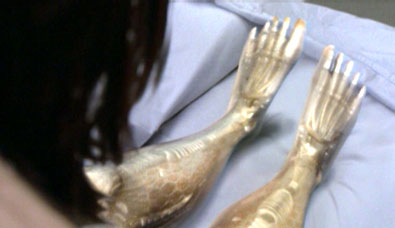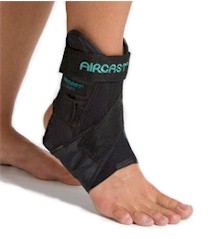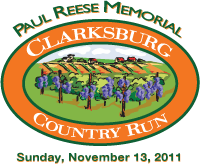Today was visit #3 to my PAMF podiatrist, Dr. Saxena.
The briefest of recaps from visits #1 & 2:
- I have a moderate case of MTSS that is most likely caused by over-pronation that isn't being corrected sufficiently by stability shoes & semi-custom orthotics.
- A few weeks of TheraBand exercises to strengthen the small muscles in the lower legs often corrects the trouble but in my case didn't.
- The next steps were to try custom orthotics as a long-term preventative measure & air casts as a temporary measure to let the damaged soft tissue heal. Also, I can keep following my same training schedule as long as I don't experience any bleeding-out-the-eyeballs levels of pain.
- I got the air casts but found them quite uncomfortable to run in for more than a mile and a half -- they felt like vice grips on the back of my foot.
(You can read about visits #1 & #2 in greater detail here and here, if you're, like, super into reading about podiatry or shin splints or Paula Radcliffe's bunions. Or if you're in the Bay Area & looking for a good podiatrist.)
So I went in today to be fitted for the orthotics. Now, I took my camera & had this whole grand plan involving documenting the process step-by-step, but it turns out to actually be a pretty quick, undramatic process and was over before there was really anything to document. (It also turns out that you have to lay face down on an exam table while you get your feet wrapped in warm plaster, so as you might imagine that is kind of a limiting factor.)
Here is a picture I found on the internet to make up for it.
It was pretty much like that.
(To prove I'm not completely morally bankrupt, here is the source.)
Regarding the air casts, Dr. S speculated that my feet were still trying to pronate since the orthotics I have aren't quite enough, and rolling against the hard plastic splints (hence the vice-grip-type pain). His take was that, since running in them for 1.5 out of, say, ten miles basically accomplishes nothing, that I should forget about them for now & try them again when I have the custom orthotics (which should take care of the pronation).
While he wrapped & molded my feet in warm plaster, Dr. S & I chatted a bit about running & marathon training in general (remember that he was a competitive high school & college runner & a 2:45 marathoner). I think if you go to see him, it's important to know that he is very straightforward as doctors go and not so much about the beating around the bush and sugarcoating things, which I definitely appreciate. This wasn't too surprising after reading his Yelp reviews, which are mostly quite good with a few abysmal ones here & there. As far as I could tell, people who gave him low ratings seem to want more of an avuncular sycophant who will confirm what they already believe (or want to believe) than a skilled doctor who will be straight with them & get them healthy again.
This was in evidence when he asked me if I had any particular goals for CIM, like qualifying for Boston. I told him about how I thought somewhere in the 3:20 - 3:30 range was probably a reasonable expectation based on my times at other distances, but that since it was my first marathon I was much more concerned with learning the preparation process and having a strong race. He asked me what my 10K time was and I told him around 44 minutes. "Yeah, you've got to be faster than that to run 3:20," he replied frankly. Heh. I'm sure this is completely true and I will be lucky to break 3:30 even if I have a perfect race.
We also talked about my mileage & how I was approaching training. I told him how I had started my marathon training at about 40 miles per week & wanted to peak somewhere between 50 & 55 miles per week. He said he firmly believed that 40 miles a week is about the minimum in terms of getting through a marathon with any modicum of health. (I'm pretty sure he meant people who are running with some sort of time / performance goal in mind, not people whose only goal is to finish.) "But obviously," he added, "the more you can run, the faster you'll be." His opinion seemed to pretty much be that 40 miles / week is a minimum for finishing a marathon safely, healthily, & with a respectable time, and that you really needed to be closer to 80 to really be strong at that distance. He's pretty much the first doctor (or health / fitness professional of any kind) who has actively encouraged me to build mileage as much as possible (without getting injured, obviously) as opposed to constantly warning me to back off, cut back, be conservative, etc.
Finally, we talked briefly about how I am pretty much obsessed with worrying about stress fractures. Our conversation went something like this:
Me: "So, if I had a stress fracture, I would know it, right? Right? Because I pretty much worry about this every moment of every day."
Dr. S: "Probably. But not necessarily. They can happen suddenly but it's very rare. You probably should not worry about this every moment of every day."
Me: "Okay, but how would I know?"
Dr. S: "Can you hop on one foot?"
Me: [Hops on one foot]
Dr. S: "And the other?"
Me: [Hops on the other]
Dr. S: "Does it hurt?"
Me: "No..."
Dr. S: "Yeah, it's pretty unlikely that you have a stress fracture."
Me: "Okay, but if I did start to get a stress fracture, how would I know?"
Dr. S: "So if there's a spot in your leg that pretty much hurts the whole time you're running and then you're limping after, then you might have a stress fracture."
Me: "Oh, okay. Because my legs don't usually hurt much when I'm running. It's mostly after."
Dr. S: "Yeah. That's because you don't have a stress fracture."
Me: "Okay."
Dr. S: "Seriously. If you had a stress fracture, you probably would not be able to run at all. So chill."
So, you know. That made me feel better.
So yeah. The orthotics should be ready in about two weeks; at that point I'll go back to have them fitted into my shoes (though Dr. S. said I could still take them out & use them in other shoes, just as with my current ones). In the mean time, I'm doing alright, MTSS-wise. Every now & then I get a little stabbing pain in one of my shins, and the medial areas are still very tender after I run, but for the most part it doesn't interfere too much. (Also, ice helps a lot with the pain. Which, all things considered, really isn't all that severe anyway.)
Tune in two weeks from now when SF Road Warrior finally becomes FULLY BIONIC!!


 This is my weekly training journal. Including it in the blog gives me a little extra accountability in the mileage department & helps me stick to my schedule. :)
This is my weekly training journal. Including it in the blog gives me a little extra accountability in the mileage department & helps me stick to my schedule. :) I only recently started occasionally reading Adam Goucher and Tim Catalano's site, Run The Edge. For the most part, they tend to post light-hearted / funny / goofy stuff related to running, so it's pretty amusing to read. Recently, though, Adam posted a more serious piece entitled
I only recently started occasionally reading Adam Goucher and Tim Catalano's site, Run The Edge. For the most part, they tend to post light-hearted / funny / goofy stuff related to running, so it's pretty amusing to read. Recently, though, Adam posted a more serious piece entitled  I'm not in the habit of carrying fluids or energy / nutritional supplements when I run. People often seem surprised by this. Don't get me wrong; I'm not saying I don't find it pleasant to be able to quench my thirst during a run. On the other hand, I am a lazy ass muthaf**** and will do pretty much anything to avoid carrying things in my hands while I'm running.
I'm not in the habit of carrying fluids or energy / nutritional supplements when I run. People often seem surprised by this. Don't get me wrong; I'm not saying I don't find it pleasant to be able to quench my thirst during a run. On the other hand, I am a lazy ass muthaf**** and will do pretty much anything to avoid carrying things in my hands while I'm running. Clearly, there is no God. I just can't believe that a just, benevolent deity could allow such a disgusting substance to exist in the world. (Seriously; I almost choked, stumbled, & spit it out onto the ground. Probably only the knowledge that I paid a freaking buck twenty-five for it kept it in.)
Clearly, there is no God. I just can't believe that a just, benevolent deity could allow such a disgusting substance to exist in the world. (Seriously; I almost choked, stumbled, & spit it out onto the ground. Probably only the knowledge that I paid a freaking buck twenty-five for it kept it in.) It is a pretty sweet day in the blogosphere when I can read two awesome sports bra posts in the same day. At
It is a pretty sweet day in the blogosphere when I can read two awesome sports bra posts in the same day. At  I have a love / hate relationship with the track. I love the soft, predictable surface. I hate the killer headwind on the backstretch ("Carl"). I love never having to pause for stop lights or dodge strollers and dogs on thirty-foot leashes. I hate the monotony of running circles.
I have a love / hate relationship with the track. I love the soft, predictable surface. I hate the killer headwind on the backstretch ("Carl"). I love never having to pause for stop lights or dodge strollers and dogs on thirty-foot leashes. I hate the monotony of running circles. The little kids whose parents will occasionally bring them to the track. I watched one little girl (4? 5? 6?) try over and over again to run an entire lap without stopping. Each time she couldn't make it, her mom would say, "Well, try again." On something like try number four she added, "Only maybe don't start out running at your top speed this time." The girl reacted as if her mother had just changed the world of long-distance running forever. The look on her face said, "You know, it's so crazy, it just might work..."
The little kids whose parents will occasionally bring them to the track. I watched one little girl (4? 5? 6?) try over and over again to run an entire lap without stopping. Each time she couldn't make it, her mom would say, "Well, try again." On something like try number four she added, "Only maybe don't start out running at your top speed this time." The girl reacted as if her mother had just changed the world of long-distance running forever. The look on her face said, "You know, it's so crazy, it just might work..." It kind of reminds me that no matter what we're doing, whether we're running two miles or ten, 100 sprints or lap after lap of steady jogging, training for a marathon or just trying to get around the track once without walking, we're all just out there, doing the best we can, trying to make ourselves a little better than we were when we got there (except for the girls that just sit on the infield....I don't know if they're really any better). It reminds me to take the long view with my running, to think about myself twenty-five years ago, challenging other kids to a lap around the school yard at recess; fifteen years ago, doing whatever I had to not to disappoint my coaches; ten, twenty, thirty years from now, hopefully still blessed enough to be able to run and be my best running self, hopefully able to inspire younger, more serious runners to remember to take the long view.
It kind of reminds me that no matter what we're doing, whether we're running two miles or ten, 100 sprints or lap after lap of steady jogging, training for a marathon or just trying to get around the track once without walking, we're all just out there, doing the best we can, trying to make ourselves a little better than we were when we got there (except for the girls that just sit on the infield....I don't know if they're really any better). It reminds me to take the long view with my running, to think about myself twenty-five years ago, challenging other kids to a lap around the school yard at recess; fifteen years ago, doing whatever I had to not to disappoint my coaches; ten, twenty, thirty years from now, hopefully still blessed enough to be able to run and be my best running self, hopefully able to inspire younger, more serious runners to remember to take the long view.
 On Monday I went back to the
On Monday I went back to the  Sigh. To be honest, it's kind of a moot point right now. The air casts aren't covered by insurance, and the cheapest I've been able to find them for is about $40 each, so $80ish in all. The orthotics are mostly covered; I'd pay 20% of somewhere between $350-400, so $70-80, plus whatever they'd charge me for the fitting. The fact of the matter, though, is that cost of the marathon and hotel room is probably more than I really should've spent on something I didn't actually need, and I certainly don't have a spare $200+ sitting around to spend on medical bills. (I've already spent $50 on the two visits alone.)
Sigh. To be honest, it's kind of a moot point right now. The air casts aren't covered by insurance, and the cheapest I've been able to find them for is about $40 each, so $80ish in all. The orthotics are mostly covered; I'd pay 20% of somewhere between $350-400, so $70-80, plus whatever they'd charge me for the fitting. The fact of the matter, though, is that cost of the marathon and hotel room is probably more than I really should've spent on something I didn't actually need, and I certainly don't have a spare $200+ sitting around to spend on medical bills. (I've already spent $50 on the two visits alone.) Ah, the long run. The sacred weekend ritual of the distance runner. The indispensable cornerstone of any training cycle. The long run.
Ah, the long run. The sacred weekend ritual of the distance runner. The indispensable cornerstone of any training cycle. The long run. I am slowly circling the long-awaited and much-anticipated (well....by me at least) post that will reveal once and for all why, after at least ten years of swearing I would never run a marathon, I've finally decided to give it a shot. This shit is crazy complex and I want to make sure I get it right. Or some reasonable approximation thereof.
I am slowly circling the long-awaited and much-anticipated (well....by me at least) post that will reveal once and for all why, after at least ten years of swearing I would never run a marathon, I've finally decided to give it a shot. This shit is crazy complex and I want to make sure I get it right. Or some reasonable approximation thereof. I'm only officially about two weeks in (on top of a solid four months of base training), but I have to say I'm pretty excited about the marathon plan I'm using. By & large, I'm following the
I'm only officially about two weeks in (on top of a solid four months of base training), but I have to say I'm pretty excited about the marathon plan I'm using. By & large, I'm following the 




